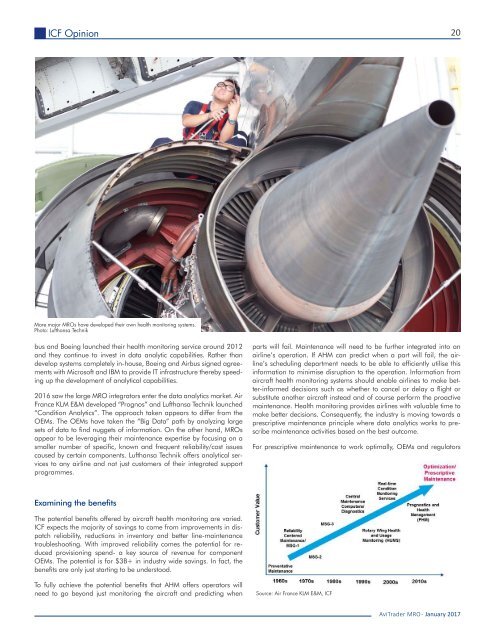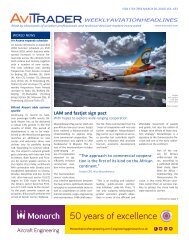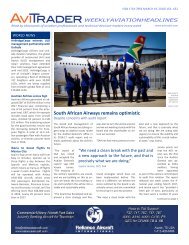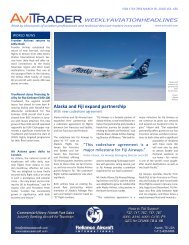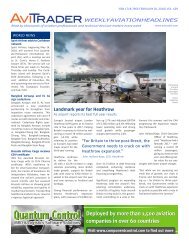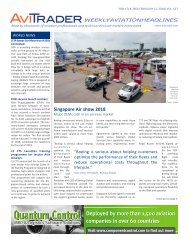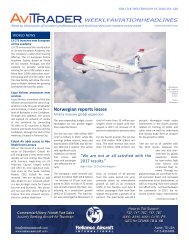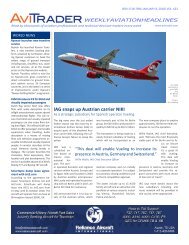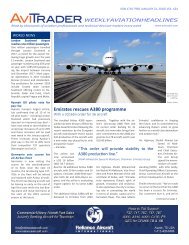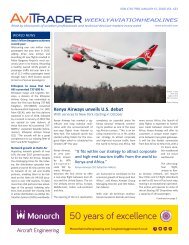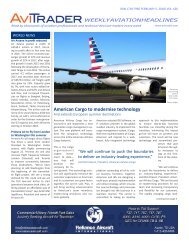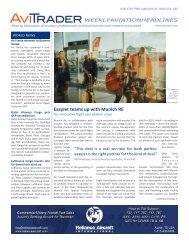AviTrader_Monthly_MRO_e-Magazine_2017-01
AviTrader_Monthly_MRO_e-Magazine_2017-01
AviTrader_Monthly_MRO_e-Magazine_2017-01
Create successful ePaper yourself
Turn your PDF publications into a flip-book with our unique Google optimized e-Paper software.
ICF Opinion<br />
20<br />
More major <strong>MRO</strong>s have developed their own health monitoring systems.<br />
Photo: Lufthansa Technik<br />
bus and Boeing launched their health monitoring service around 2<strong>01</strong>2<br />
and they continue to invest in data analytic capabilities. Rather than<br />
develop systems completely in-house, Boeing and Airbus signed agreements<br />
with Microsoft and IBM to provide IT infrastructure thereby speeding<br />
up the development of analytical capabilities.<br />
2<strong>01</strong>6 saw the large <strong>MRO</strong> integrators enter the data analytics market. Air<br />
France KLM E&M developed “Prognos” and Lufthansa Technik launched<br />
“Condition Analytics”. The approach taken appears to differ from the<br />
OEMs. The OEMs have taken the “Big Data” path by analyzing large<br />
sets of data to find nuggets of information. On the other hand, <strong>MRO</strong>s<br />
appear to be leveraging their maintenance expertise by focusing on a<br />
smaller number of specific, known and frequent reliability/cost issues<br />
caused by certain components. Lufthansa Technik offers analytical services<br />
to any airline and not just customers of their integrated support<br />
programmes.<br />
parts will fail. Maintenance will need to be further integrated into an<br />
airline’s operation. If AHM can predict when a part will fail, the airline’s<br />
scheduling department needs to be able to efficiently utilise this<br />
information to minimise disruption to the operation. Information from<br />
aircraft health monitoring systems should enable airlines to make better-informed<br />
decisions such as whether to cancel or delay a flight or<br />
substitute another aircraft instead and of course perform the proactive<br />
maintenance. Health monitoring provides airlines with valuable time to<br />
make better decisions. Consequently, the industry is moving towards a<br />
prescriptive maintenance principle where data analytics works to prescribe<br />
maintenance activities based on the best outcome.<br />
For prescriptive maintenance to work optimally, OEMs and regulators<br />
Examining the benefits<br />
The potential benefits offered by aircraft health monitoring are varied.<br />
ICF expects the majority of savings to come from improvements in dispatch<br />
reliability, reductions in inventory and better line-maintenance<br />
troubleshooting. With improved reliability comes the potential for reduced<br />
provisioning spend- a key source of revenue for component<br />
OEMs. The potential is for $3B+ in industry wide savings. In fact, the<br />
benefits are only just starting to be understood.<br />
To fully achieve the potential benefits that AHM offers operators will<br />
need to go beyond just monitoring the aircraft and predicting when<br />
Source: Air France KLM E&M, ICF<br />
<strong>AviTrader</strong> <strong>MRO</strong> - January <strong>2<strong>01</strong>7</strong>


